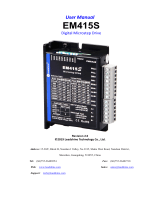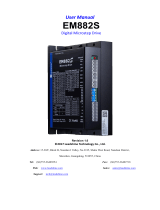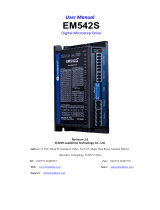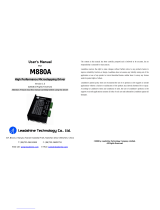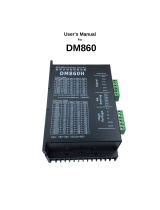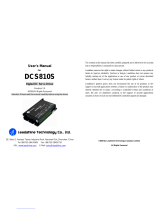Page is loading ...

User Manual
DMA860E
2-Phase Digital Stepper Drive
Hardware Version 2.0
Manual Revision 1.0
©2021 China Leadshine Technology Co., Ltd.
Address: 15-20/F, Block B, Nanshan I Valley, No.3185, Shahe West Road, Nanshan District,
Shenzhen, Guangdong, 518055, China
Tel: (86)755-26409254 Fax: (86)755-26402718
Web: www.leadshine.com Sales: sales@leadshine.com
Support: tech@leadshine.com

DMA860E Digital Stepper Drive User Manual
Notice
Read this manual carefully before any assembling and using. Incorrect handling of products in this manual can result
in injury and damage to persons and machinery. Strictly adhere to the technical information regarding installation
requirements.
This manual is not for use or disclosure outside of Leadshine except under permission. All rights are reserved. No part
of this manual shall be reproduced, stored in retrieval form, or transmitted by any means, electronic, mechanical,
photocopying, recording, or otherwise without approval from Leadshine. While every precaution has been taken in
the preparation of the book, Leadshine assumes no responsibility for errors or omissions. Neither is any liability
assumed for damages resulting from the use of the information contained herein.
This document is proprietary information of Leadshine that is furnished for customer use ONLY. Information in this
document is subject to change without notice and does not represent a commitment on the part of Leadshine.
Therefore, information contained in this manual may be updated from time-to-time due to product improvements,
etc., and may not conform in every respect to former issues.
Record of Revisions
Manual Revision
Date
Description of Release
1.0
Oct, 2021
Initial Release

DMA860E Digital Stepper Drive User Manual
Table of Contents
1. Introductions...........................................................................................................................................................................................................................1
1.1 Features.........................................................................................................................................................................................................................1
1.2 Applications................................................................................................................................................................................................................ 1
2. Specifications..........................................................................................................................................................................................................................1
2.1 Electrical Specifications.......................................................................................................................................................................................... 1
2.2 Environment..............................................................................................................................................................................................................2
2.3 Mechanical Specifications.................................................................................................................................................................................... 2
2.4 Elimination of Heat................................................................................................................................................................................................. 2
3. Connection Pin Assignments and LED Indication......................................................................................................................................................3
3.1 P1 - Control Connector............................................................................................................................................................................................ 3
3.2 P2 - Fault and Brake Output Connector............................................................................................................................................................. 3
3.3 P3 - Motor and Power Supply Connector..........................................................................................................................................................4
3.4 P4 - Tuning Connector........................................................................................................................................................................................... 4
3.5 LED Light Indication............................................................................................................................................................................................... 4
4. Control Signal and Output Signal....................................................................................................................................................................................4
4.1 Control Signal Connection....................................................................................................................................................................................4
4.2 Fault and Brake Output Connection...................................................................................................................................................................5
5. Motor Connection................................................................................................................................................................................................................6
5.1 Connections of 4-lead Motor................................................................................................................................................................................ 6
5.2 Connections of 6-lead Motor................................................................................................................................................................................6
5.2.1 Half Coil Configuration.............................................................................................................................................................................6
5.2.2 Full Coil Configuration............................................................................................................................................................................. 6
5.3 Connections of 8-lead Motor................................................................................................................................................................................7
5.3.1 Series Connection....................................................................................................................................................................................... 7
5.3.2 Parallel Connection....................................................................................................................................................................................7
6. Power Supply Selection.......................................................................................................................................................................................................7
6.1 Regulated or Unregulated Power Supply.......................................................................................................................................................... 7
6.2 Power Supply Sharing.............................................................................................................................................................................................8
6.3 Selecting Supply Voltage....................................................................................................................................................................................... 8
7. DIP Switch Configurations.................................................................................................................................................................................................8
7.1 Microstep Resolution Configurations............................................................................................................................................................... 8
7.2 Output Current Configurations...........................................................................................................................................................................9
7.2.1 Dynamic Current Configurations..........................................................................................................................................................9
7.2.2 Idle Current Configuration..................................................................................................................................................................... 9
7.3 Control Mode Configurations..............................................................................................................................................................................9
7.4 Smoothing Time Configuration........................................................................................................................................................................ 10
7.3 Automatic Motor Matching & Self Configuration....................................................................................................................................... 10
8. Wiring Notes........................................................................................................................................................................................................................10
9. Typical Connection............................................................................................................................................................................................................10
10. Sequence Chart of Control Signals.............................................................................................................................................................................. 11
11. Protection Functions......................................................................................................................................................................................................... 11
12. Troubleshooting................................................................................................................................................................................................................ 12
13. Warranty..............................................................................................................................................................................................................................13
14. Contact Us............................................................................................................................................................................................................................13

DMA860E Digital Stepper Drive User Manual
Page | 1
1. Introductions
The DMA860E is a digital stepper drive with simple design and easy setup. By implementing Leadshine advanced
stepper control technology, this stepper drive is able to power 2-phase and 4 phase stepper motors smoothly with
optimal torque and low motor heating & noise. Its operating voltage is 18-80VAC or 24-110VDC and it can output up
to 7.2A current. All the micro step and output current configurations can be easily done via built in DIP switches. Its
control type (step & direction or CW/CCW) and command smooth filtering can also be configured via DIP switches.
Therefore, the DMA860E are ideal choices for applications requiring simple step & direction control of NEMA 23, 24,
34, and 42 stepper motors.
1.1 Features
Step & direction (PUL/DIR) or CW/CCW (double pulse) control
Input voltage 18-80VAC or 24-110VDC (recommended 20-70VAC or 30-90VDC)
200 KHz max pulse input frequency
16 microstep resolutions of 400-51,200 via DIP switches, or 200-51,200 via software (increase by 200)
8 output current settings of 2.4-7.2A via DIP Switches, or 1.0-7.2A via software (increase by 0.1)
Configurable control command smoothing for reducing motor vibration
Idle current reduction to 50% or 90% selection via SW4
Auto-tuning to match wide-range NEMA 23, 24, 34 and 42 stepper motors
Anti-Resonance for optimal torque, extra smooth motion, low motor heating and noise
Soft-start with no “jump” when powered on
Optically isolated inputs with 5V or 24V
Fault and Brake outputs
Over-voltage and over-current protections
1.2 Applications
The DMA860E stepper drive are designed to power 2 phase (1.8°) or 4-phase (0.9°) NEMA 23, 24, 34, and 42 hybrid
stepper motors. It can be easily adopted in many industries (CNC, medical, automation, packaging…), such as X-Y
tables, engraving machines, labeling machines, mills, plasma, laser cutters, pick and place devices, and so on. Its
excellent performance, simple design, and easy setup make it ideal for many step & direction control type applications.
2. Specifications
2.1 Electrical Specifications
Parameters
DMA860E
Min
Typical
Max
Unit
Output Current
2.4
-
7.2
A
Supply Voltage
18
24
20 - 70
30 - 90
80
110
VAC
VDC
Logic signal current
7
10
16
mA
Pulse input frequency
0
-
200
kHz
Minimal Pulse Width
2.5
-
-
μS

DMA860E Digital Stepper Drive User Manual
Page | 2
Minimal Direction Setup
5.0
-
-
μS
Isolation resistance
500
MΩ
2.2 Environment
Cooling
Natural Cooling or Forced cooling
Operating Environment
Environment
Avoid dust, oil fog and corrosive gases
Ambient Temperature
0°C -65°C (32°F - 149°F)
Humidity
40%RH-90%RH
Operating Temperature
0°C -50°C (32°F - 122°F)
Vibration
10-50Hz / 0.15mm
Storage Temperature
-20°C -65°C (-4°F - 149°F)
Weight
Approx. 510g (1.13 lbs)
2.3 Mechanical Specifications
(unit: mm [1inch=25.4mm])
Figure 1 Mechanical specifications
Side mounting recommended for better heat dissipation
2.4 Elimination of Heat
DMA860E reliable working temperature should be < 60℃(140°F)
It is recommended to use automatic idle-current mode to reduce motor heating. That means set the SW4 pin of
DIP switch at “OFF” position.
It is recommended to mount the drive vertically to maximize heat sink area. Use forced cooling method to cool if
necessary.

DMA860E Digital Stepper Drive User Manual
Page | 3
3. Connection Pin Assignments and LED Indication
Figure 2 Connectors, DIP switches, and LED locations
The DMA860E has three connector blocks P1&P2&P3 (see above picture). P1 is for control signals connections, and
P2 is for output signals connections, P3 is for power and motor connections. The following tables are brief descriptions
of the three connectors. More detailed descriptions of the pins and related issues are presented in section 4, 5, 9.
3.1 P1 - Control Connector
PIN
Details
PUL+ (CW+)
Pulse and Direction Connection:
(1) Optically isolated, high level 4.5-5V or 24V, low voltage 0-0.5V
(2) Maximum 200 KHz input frequency
(3) The width of PUL signal is at least 2.5μs, duty cycle is recommended 50%
(4) Single pulse (step & direction) or double pulse (CW/CCW) is set by DIP Switch SW9
(5) DIR signal requires advance PUL signal minimum 5 μs in single pulse mode
(6) The factory setting of control signal voltage is 24V, must need to set S2 (figure 2) if it is 5V
PUL- (CW-)
DIR+ (CCW+)
DIR- (CCW-)
ENA+
Enable Connection: (default no connection)
(1) Optically isolated, differential.
(2) Disable the drive by 4.5- 24V input connection; enable the drive by 0-0.5V connection
(3) ENA signal requires advance DIR signal minimum 5μs in single pulse mode
(4) Enable time to be at least 200ms
ENA-
Notes:
(1) Shield cables are required for P1;
(2) Don’t tie P1/P2 cables and P3 cables together.
3.2 P2 - Fault and Brake Output Connector
Pin
Details
BRK+
(1) Maximum 30V/100mA output
(4) Brake connection refer to chapter 4.2
BRK-

DMA860E Digital Stepper Drive User Manual
Page | 4
ALM+
(1) Maximum 30V/100mA output
(2) Sinking or sourcing
(3) The resistance between ALM+ and ALM- is low impedance as default, and will change to
high when the drive goes into error protection.
(4) Fault connection refer to chapter 4.3
ALM-
3.3 P3 - Motor and Power Supply Connector
Pin Function
Details
A+, A-
Motor Phase A connections. Connect motor A+ wire to A+ Pin; motor A- wire to A-
B+, B-
Motor Phase B connections. Connect motor B+ wire to B+ Pin; motor B- wire to B-
AC
Power supply input 18-80VAC or 24-110 VDC(recommended 20-70VAC or 30-90VDC);
No polarity
AC
!
Warning
Warning: (1) Don’t plug or unplug the P1 & P2&P3 terminal block to avoid drive damage or injury when
DMA860E is powered on. (2) If using an AC transformer, be sure to use a transformer with isolation.Otherwise there is
a risk of electrocution
3.4 P4 - Tuning Connector
DMA860E has a tuning port with RS232 to modify the drive parameters, it is just used to modify parameter, not for
equipment control because neither precision nor stability is sufficient. If you need a field bus drive, use a Leadshine
RS485 or EtherCAT type drives:
(http://www.leadshine.com/ProductSubType.aspx?type=products&category=stepper-products&producttype=stepper-dr
ives&subtype=network-stepper-drives
The interface definition is as follows:
Figure 3: RS232 connector
3.5 LED Light Indication
There are two LED lights for DMA860E. The GREEN one is the power indicator which will be always on generally.
The RED one is a protection indicator which will flash 1-2 times in a 3-second period, when protection enabled for a
DMA860E. Different number of flashes indicates different protection type (read section 11 for detail).
4. Control Signal and Output Signal
4.1 Control Signal Connection
The DMA860E can accept can accept differential or single-ended control signals (pulse, direction, and enable) in

DMA860E Digital Stepper Drive User Manual
Page | 5
open-collector or PNP connection through the P1 connector (figure 2). It is recommend to add an EMI line filter
between the power supply and the drive to increase noise immunity for the drive in interference environments.
Figure 4: Connections to open-collector signal Figure 5: Connections to PNP signal
(common-anode) (common-cathode)
Notes:
(1) ENA signal is no-connected as default;
(2) Control signal amplitude is 24 V as default. If it is 12 V, please set the S2 (Figure 2) selector switch to 5 V first, then
connect 1KΩresistor; If it is 5V, please set the S2 to 5V.
4.2 Fault and Brake Output Connection
Fault Output
When over voltage or over current protection happens, DMA860E red status LED light will blink and the impedance
state between ALM+ and ALM- will change (from low to high or high to low depending on configuration) and can thus
be detected. Fault output connection is optional, and it can be connected either in sinking or sourcing.
Figure 6 Sinking output Figure 7 Sourcing output
Brake Control
It is recommended to connect a fly-wheel diode in parallel to a 24VDC relay and brake coil connection. Refer to the
following figure for brake connection.
Figure 8 Brake output
Drive
Controller
VCC
PUL-
PUL+
ENA-
PUL
DIR
ENABLE
DIR-
DIR+
ENA+
Drive
Controller
VCC PUL-
PUL+
ENA-
PUL
DIR
ENABLE
DIR-
DIR+
ENA+

DMA860E Digital Stepper Drive User Manual
Page | 6
5. Motor Connection
The DMA860E can drive 2-phase and 4-pahse bipolar hybrid stepper motors with 4, 6, or 8 wires.
5.1 Connections of 4-lead Motor
The 4 lead motors are the least flexible and easy to connect. And the Speed – torque of motor depends on winding
inductance. The output current from drive that is multiply the specified phase current by 1.4 to determine the peak
output current.
Figure 9: 4-lead Motor Connections
5.2 Connections of 6-lead Motor
Like 8 lead stepping motors, 6 lead motors have two configurations available for high speed or high torque operations.
The higher speed configuration, or half coil, is described, because it uses one half of the motor’s inductor windings.
The higher torque configuration, or full coil, uses the full coil windings.
5.2.1 Half Coil Configuration
As previously stated, the half coil configuration uses 50% of the motor phase windings. This gives lower inductance,
hence, lower torque output. Like the parallel connection of 8 lead motor, the torque output will be more stable at higher
speeds. This configuration is also referred to as half chopper. In setting the drive output current multiply the specified
per phase (or unipolar) current rating by 1.4 to determine the peak output current.
Figure 10: 6-lead motor half coil (higher speed) connections
5.2.2 Full Coil Configuration
The full coil configuration on a six lead motor should be used in applications where higher torque at lower speed is
desired. This configuration is also referred to as full copper. In full coil mode, the motors should be run at only 70% of
their rated current to prevent overheating.
Figure 11: 6-lead motor full coil (higher torque) connections

DMA860E Digital Stepper Drive User Manual
Page | 7
5.3 Connections of 8-lead Motor
8 lead motors offer a high degree of flexibility to the system designer in that they may be connected in series or parallel,
thus satisfying a wide range of applications.
5.3.1 Series Connection
A series motor configuration would typically be used in applications where a higher torque at lower speed is required.
Because this configuration has the most inductance, the performance will start to degrade at higher speed. In series
mode, the motors should also be run at only 70% of their rated current to prevent overheating.
Figure 12: 8-lead motor series connections
5.3.2 Parallel Connection
An 8 lead motor in a parallel configuration offers a more stable, but lower torque at lower speeds. But because of the
lower inductance, there will be higher torque at higher speeds. Multiply the per-phase (or unipolar) current rating by
1.96, or the bipolar current rating by 1.4, to determine the peak output current.
Figure 13: 8-lead motor parallel connections
6. Power Supply Selection
The DMA860E can power medium and large size stepping motors (frame size from NEMA 23 to 42) made by
Leadshine or other motor manufacturers. To get good driving performances, it is important to select supply voltage and
output current properly. Generally speaking, supply voltage determines the high speed performance of the motor, while
output current determines the output torque of the driven motor (particularly at lower speed). Higher supply voltage
will allow higher motor speed to be achieved, at the price of more noise and heating. If the motion speed requirement is
low, it’s better to use lower supply voltage to decrease noise, heating and improve reliability.
6.1 Regulated or Unregulated Power Supply
Both regulated and unregulated power supplies can be used to supply the drive. However, unregulated power supplies
are preferred due to their ability to withstand current surge and fast response for current change. If you prefer to a
regulated power supply, it is suggested to choose such a power supply specially designed for stepper/servo controls
such as Leadshine LSP series power suppliers. Or, in the case when only normal switching power supplies are
available, it is important to use “OVERSIZE” high current output rating power supplies (for example, using a 4A
power supply for 3A stepper motor) to avoid problems such as current clamp. On the other hand, if unregulated supply

DMA860E Digital Stepper Drive User Manual
Page | 8
is used, one may use a power supply of lower current rating than that of motor (typically 50%~70% of motor current).
The reason is that the drive draws current from the power supply capacitor of the unregulated supply only during the
ON duration of the PWM cycle, but not during the OFF duration. Therefore, the average current withdrawn from
power supply is considerably less than motor current. For example, two 3A motors can be well supplied by one power
supply of 4A rating.
6.2 Power Supply Sharing
Multiple DMA860E drives can share one power supply to reduce cost, if that power supply has enough power capacity.
To avoid cross interference, connect each stepper drive directly to the shared power supply separately. To avoid cross
interference, DO NOT daisy-chain connect the power supply input pins of the Drivers. Instead connect them to power
supply separately.
6.3 Selecting Supply Voltage
The DMA860E is designed to operate within 18 - 80VAC or 24-110VDC voltage input. When selecting a power supply,
besides voltage from the power supply power line voltage fluctuation and back EMF voltage generated during motor
deceleration needs also to be taken into account. Please make sure leaving enough room for power line voltage
fluctuation and back-EMF voltage charge back.
Higher supply voltage can increase motor torque at higher speeds, thus helpful for avoiding losing steps. However,
higher voltage may cause bigger motor vibration at lower speed, and it may also cause over-voltage protection or even
drive damage. Therefore, it is suggested to choose only sufficiently high supply voltage for intended applications.
7. DIP Switch Configurations
The DMA860E has one 10-bit DIP switch and one 1-bit selector. The first 10-bit is used to configure settings of micro
step resolution, output current, motor standstill current, pulse type and smoothing time as shown below.
SW1
SW2
SW3
SW4
SW5
SW6
SW7
SW8
SW9
SW10
The second 1-bit selector is located on the top (S2 in figure 2), used to configure the voltage of control signals. For the
safety of optically coupled, the factory setting is 24V, which no need to connect 2K resistors like the old drives, making
it easier to use. When the voltage of the control signal is 5V, the S2 must be set to 5V, otherwise, the motor won't work.
7.1 Microstep Resolution Configurations
Microstep resolution is set by SW5, 6, 7, 8 of the DIP switches as shown in the following table, default means can be
set by Leadshine ProTuner
Microstep
Steps/rev.(for 1.8°motor)
SW5
SW6
SW7
SW8
2
400(default)
ON
ON
ON
ON
4
800
OFF
ON
ON
ON
8
1600
ON
OFF
ON
ON
16
3200
OFF
OFF
ON
ON
32
6400
ON
ON
OFF
ON
64
12800
OFF
ON
OFF
ON
128
25600
ON
OFF
OFF
ON
Idle Current
Output Current
Microstep
Control Mode
Smoothing Time

DMA860E Digital Stepper Drive User Manual
Page | 9
256
51200
OFF
OFF
OFF
ON
5
1000
ON
ON
ON
OFF
10
2000
OFF
ON
ON
OFF
20
4000
ON
OFF
ON
OFF
25
5000
OFF
OFF
ON
OFF
40
8000
ON
ON
OFF
OFF
50
10000
OFF
ON
OFF
OFF
100
20000
ON
OFF
OFF
OFF
200
40000
OFF
OFF
OFF
OFF
7.2 Output Current Configurations
For a given motor, higher drive current will make the motor to output more torque, but at the same time causes more
heating in the motor and drive. Therefore, output current is generally set to be such that the motor will not overheat for
long time operation. Since parallel and serial connections of motor coils will significantly change resulting inductance
and resistance, it is therefore important to set drive output current depending on motor phase current, motor leads and
connection methods. Phase current rating supplied by motor manufacturer is important in selecting drive current,
however the selection also depends on leads and connections.
The first three bits (SW1, 2, 3) of the DIP switch are used to set the dynamic current. Select a setting closest to your
motor’s required current.
7.2.1 Dynamic Current Configurations
Peak Current
RMS Current
SW1
SW2
SW3
2.40A(default)
1.70A
ON
ON
ON
3.08A
2.18A
OFF
ON
ON
3.77A
2.67A
ON
OFF
ON
4.45A
3.15A
OFF
OFF
ON
5.14A
3.64A
ON
ON
OFF
5.83A
4.12A
OFF
ON
OFF
6.52A
4.61A
ON
OFF
OFF
7.20A
5.09A
OFF
OFF
OFF
Notes: Due to motor inductance, the actual current in the coil may be smaller than the dynamic current setting,
particularly under high speed condition. Default means can be set by Leadshine ProTuner
7.2.2 Idle Current Configuration
SW4 is used to set motor idle current percentage. At OFF position it means the standstill current is set to be 50% of the
selected output current. At ON position it means standstill current is set to be 90%.
The current automatically reduced to 50% of the selected dynamic current 0.4 second after the last pulse.
7.3 Control Mode Configurations
DIP switch SW9 is used to configure the control mode. Factory setting is single pulse (step & direction, or pulse &
direction) control. Setting to ON to change the control model to double pulse (CW/CCW) control type.

DMA860E Digital Stepper Drive User Manual
Page | 10
7.4 Smoothing Time Configuration
DMA860E has an advanced feature called control command smoothing to make the input pulse from pulse generator
(controller, PLC, etc.) S-curve acceleration, to improve motion smoothness and high-speed start frequency in many
circumstances. This is achieved through adding filtering time which is configured SW10. Setting to ON to activate the
feature with 12ms acceleration time.
7.3 Automatic Motor Matching & Self Configuration
When powered on a DMA860E will automatically configure itself with the best settings to match the driven stepper
motor for optimal performance. No action is needed.
8. Wiring Notes
In order to improve anti-interference performance of the drive, it is recommended to use twisted pair shield cable.
To prevent noise incurred in PUL/DIR signal, pulse/direction signal wires and motor wires should not be tied up
together. It is better to separate them by at least 10 cm, otherwise the disturbing signals generated by motor will
easily disturb pulse direction signals, causing motor position error, system instability and other failures.
If only one power supply serves multiple DMA860E drives, separately connecting the drives to the power supply
is recommended instead of daisy-chaining.
It is prohibited to pull and plug connector P2 while the drive is powered ON, because there is high current flowing
through motor coils (even when motor is at standstill). Pulling or plugging connector P2 with power on will cause
extremely high back-EMF voltage surge, which may damage the drive.
9. Typical Connection
A complete stepping system should include stepping motor, stepping drive, power supply and controller (pulse
generator). A typical connection is shown as below.
Figure 14: Typical connection

DMA860E Digital Stepper Drive User Manual
Page | 11
10. Sequence Chart of Control Signals
In order to avoid some fault operations and deviations, PUL, DIR and ENA should abide by some rules, shown as
following diagram:
Figure 15: Sequence chart of control signals
Remark:
a) t1: ENA must be ahead of DIR by at least 5ms. Usually, ENA+ and ENA- are NC (not connected). See
“Connector P1 Configurations” for more information.
b) t2: DIR must be ahead of PUL effective edge by 5s to ensure correct direction;
c) t3: Pulse width not less than 2.5s;
d) t4: Low level width not less than 2.5s.
11. Protection Functions
To improve reliability, the drive incorporates some built-in protections features.
Priority
Time(s) of
Blink
Sequence wave of red LED
Description
1st
1
Over-current protection activated when peak
current exceeds the limit.
2nd
2
Over-voltage protection activated when drive
working voltage is greater than 160VDC
3nd
3
Reserved.
When above protections are active, the motor shaft will be free or the red LED blinks. Reset the drive by repowering it
to make it function properly after removing above problems.

DMA860E Digital Stepper Drive User Manual
Page | 12
12. Troubleshooting
In the event that your drive doesn’t operate properly, the first step is to identify whether the problem is electrical or
mechanical in nature. The next step is to isolate the system component that is causing the problem. As part of this
process you may have to disconnect the individual components that make up your system and verify that they operate
independently. It is important to document each step in the troubleshooting process. You may need this documentation
to refer back to at a later date, and these details will greatly assist our Technical Support staff in determining the
problem should you need assistance.
Many of the problems that affect motion control systems can be traced to electrical noise, controller software errors, or
mistake in wiring.
Problem Symptoms and Possible Causes
Symptoms
Possible Problems
Motor is not rotating
No power
Microstep resolution setting is wrong
DIP switch current setting is wrong
Fault condition exists
The drive is disabled
Motor rotates in the wrong direction
Motor phases may be connected in reverse
The drive in fault
DIP switch current setting is wrong
Something wrong with motor coil
Erratic motor motion
Control signal is too weak
Control signal is interfered
Wrong motor connection
Something wrong with motor coil
Current setting is too small, losing steps
Motor stalls during acceleration
Current setting is too small
Motor is undersized for the application
Acceleration is set too high
Power supply voltage too low
Excessive motor and drive heating
Inadequate heat sinking / cooling
Automatic current reduction function not being utilized
Current is set too high

DMA860E Digital Stepper Drive User Manual
Page | 13
13. Warranty
Twelve Month Warranty
Leadshine Technology Co., Ltd. warrants its products against defects in materials and workmanship for a period of 12
months from shipment out of factory. During the warranty period, Leadshine will either, at its option, repair or replace
products which proved to be defective.
Exclusions
The above warranty does not extend to any product damaged by reasons of improper or inadequate handlings by
customer, improper or inadequate customer wirings, unauthorized modification or misuse, or operation beyond the
electrical specifications of the product and/or operation beyond environmental specifications for the product.
Obtaining Warranty Service
To obtain warranty service, please contact your seller to obtain a returned material authorization number (RMA) before
returning product for service.
Shipping Failed Products
If your product fail during the warranty period, please contact your seller for how and where to ship the failed product
for warranty or repair services first, you can also e-mail customer service at [email protected] to obtain a returned material
authorization number (RMA) before returning product for service. Please include a written description of the problem along with contact
name and address.
14. Contact Us
China Headquarter
Address: Floor 11, Block A3, Nanshan iPark, Xueyuan Avenue 1001, Shenzhen, Guangdong, 518055, China
Web: http://www.leadshine.com
Sales Hot Line:
Tel: 86-755-2643 4369 (for All)
86-755-2641-7674 (for Asia, Australia, Africa areas)
86-755-2640-9254 (for Europe, America areas)
Fax: 86-755-2640-2718
Email: sales@leadshine.com.
Technical Support:
Tel: 86 755-2641-8447 and 86-755-2647-1129
Fax: 86-755-2640-2718
Email: tech@leadshine.com.
Leadshine U.S.A
Address: 26050 Towne Centre Dr. Foothill Ranch, CA 926 USA
Tel: 1-949-608-7270
Fax: 1-949-608-7298
Web: http://www.leadshineusa.com
Email: sales@leadshineusa.com and support@leadshineusa.com
/

